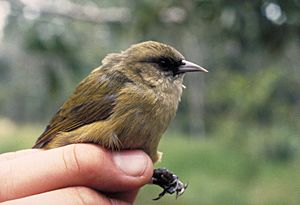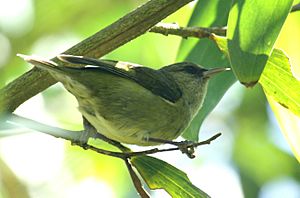Hawaiʻi creeper facts for kids
Quick facts for kids Hawaiʻi creeper |
|
|---|---|
 |
|
| Conservation status | |
| Scientific classification | |
| Genus: |
Loxops
|
| Species: |
mana
|
| Synonyms | |
|
Manucerthia mana |
|
The Hawaiʻi creeper, also called the Hawaii creeper or ʻalawī, is a special bird found only on the Big Island of Hawaiʻi. It is a type of Hawaiian honeycreeper. These birds live in dry forests and moist forests on mountains. They are found at heights between 1,000 and 2,300 meters (about 3,300 to 7,500 feet).
There are about 12,000 Hawaiʻi creepers, split into three main groups. A fourth group on the west side of the island might be birds that have moved from one of the other groups. This bird is about 11.4 centimeters (4.5 inches) long. It has dull green feathers. In 2017, its old Hawaiian name, 'alawi, was found again.
Diet and Food
The Hawaiʻi creeper can climb up and down trees, much like other treecreepers. It uses its short, sharp beak to look for insects. It pokes under the bark of trees to find them. If it can, the bird will also drink nectar from koa (Acacia koa) or ʻōhiʻa lehua (Metrosideros polymorpha) trees.
Reproduction and Life Cycle
The Hawaiʻi creeper's breeding season is from April to July. During this time, female birds lay one to three eggs. They hide their nests inside a tree hole or build them on a high branch. Nests are usually in koa (Acacia koa) or ʻōhiʻa lehua (Metrosideros polymorpha) trees. The eggs hatch after about thirteen days.
Conservation Efforts
The Hawaiʻi creeper was listed as an endangered species in 1975. At first, it was not clear if the bird was truly endangered or just rare [1]. Even though their homes have been damaged, these birds have still been able to have babies. So, habitat damage is not thought to be the biggest problem for them.
These birds have also been found in lower areas, like the common ʻamakihi. They seem to handle diseases better than some other bird species. However, new animals brought to Hawaii have caused problems for the Hawaiʻi creeper. These new animals compete with the creepers for food. Also, predators like rats eat the birds, which makes their numbers drop quickly. Hawaiʻi creeper nests are often low to the ground, making them easy targets for predators [2]. Rats eat their eggs, chicks, and even adult birds.
Today, the northern group of Hawaiʻi creepers is protected. They live in the same area as the ʻakiapolaʻau and other native birds, at the Hakalau Forest National Wildlife Refuge. The Hawaiʻi creeper is still threatened by diseases and loss of its home. But, protecting other endangered birds in Hawaii has likely helped the Hawaiʻi creeper too [3].
See also
 In Spanish: Akikiki de Hawái para niños
In Spanish: Akikiki de Hawái para niños



